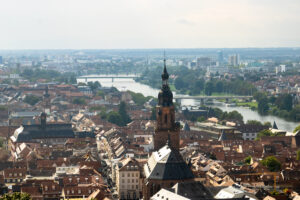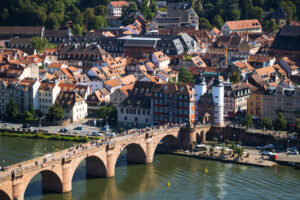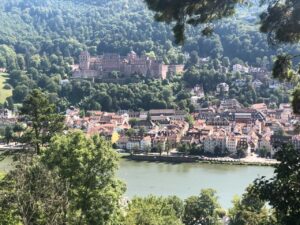by Kathryn Baker ’23
I’ve already visited the Bremen Christmas markets twice, and it’s amazing. It is absolutely gorgeous at night and it always smells delicious. I would highly recommend trying the Schmalzkuchen and the Apfeltaschen! 

by Dr. Janine Ludwig
In this webinar, Professor Janine Ludwig will explain the German party system and its complicated voting system. She’ll discuss what the parties stand for, which coalitions they normally prefer—conservative-liberal, red-green or grand. Then she’ll recall the thrilling events of a rollercoaster election campaign, in which three chancellor candidates and their parties gained and lost up to 10 percentage points in the polls, following severe mishaps. Finally, she’ll analyze the election results and why, for quite a while, it was not certain at all who would govern the country in the future. The only thing everyone was sure of was that it would be a new kind of coalition that had never been tried before and that, for the first time, the smaller parties would dictate who would become chancellor.
The webinar will take place on Tuesday, December 7, 2021 at 10 a.m. Eastern time (16 Uhr/4 p.m. in Germany).
by Brendan Harlan ’22
The Dickinson in Bremen (DiB) program has students begin their German abroad experience not in Bremen, but instead in another city. The German Fall semester doesn’t start until October, which is why it’s called the Winter semester, so Dickinson students have roughly five weeks between when they would usually start the Fall semester in Carlisle versus when classes begin in Bremen. That time is reserved for incoming DiB students to enroll in an intensive language course for four weeks, typically in a city of their choice. However, the ongoing COVID-19 pandemic meant that DiB arranged for us current students to join a program in the beautiful city of Heidelberg. I couldn’t have been happier though.
I spent four weeks in Heidelberg in a language program that met five mornings a week. The course I was in usually catered to people looking to work in Germany and needing additional language skills to do so. I learned German alongside future Uni students from South Korea and Ecuador, a future cook from China, and a future doctor from Iraq. I was the only native English speaker and the lone student from North America. However, I enjoyed learning more about Germany from my teacher and hearing about my classmates’ pasts as we practiced our German speaking skills.
The program in Heidelberg also provided housing to its students. I lived in a single room on the third floor of a house that was roughly a 20-minute tram ride from the program’s classrooms. My floor consisted of a small kitchen and tinier bathroom that I shared with two doctors-in-training from Turkey and a postgrad German Studies student from Alabama. It was here that I was introduced to my first Putzplan (cleaning schedule) and I had a difficult time rummaging through cleaning supplies with their purposes written entirely in German. My room was awesome though and when the skylight was open, I liked being able to hear the passing trams at the end of the street.
I enjoyed noticing things that clearly differentiated Heidelberg from any US city I’d been to. The German elections happened at the end of September, so virtually every light pole in the city had a smattering of political signs up. In the grocery stores, it was expected that you bring your own bag or pay for either a reusable bag or a paper bag. I somehow managed to shop at four different grocery store chains (Aldi, Rewe, Edeka, and Penny) in Heidelberg, though I found myself challenged at each by needing to bag my own groceries as fast as possible. And yes, public transportation here is awesome and despite a few close calls, I also managed to avoid getting run over by a bicyclist when I would accidentally stand in the bike lane.
My other favorite parts of my time in Heidelberg included exploring the Altstadt, getting coffee in the city, and the various meals I had in the city or at my house. I took my camera to the Altstadt multiple times, where I visited the Schloss (castle), Alter Brücke (old bridge), and Philosophenweg (Philosopher’s Way). My favorite photos of the Altstadt are already on this blog, so I won’t repeat post them here. The Altstadt was where I would see hundreds of tourists and I often (mentally) cursed the fact that Yankees hats are the fashionable baseball cap in Europe, not the Red Sox. I enjoyed a couple meals in the Altstadt too, including one with a view across the bridge and another beneath the shadows of one of the large steepled churches.
During the 20-minute daily break in my class, I would join my fellow students at the nearby Rieglers, a chain bakery/café where I could snag a cheap cappuchino and an Apfelstrudel for a snack (or breakfast). I also found a cool coffee shop called Kaffeezimmer, where I would go to study German or edit my photos while sipping at a coffee and eating cheesecake. The first time I went to Kaffeezimmer, I stumbled with my German and somehow said no thanks to the Wifi password, but it got better from then on.
I befriended three people living on the second floor of the house I lived in. The three included Uni Students from South Korea, the United Arab Emirates, and Germany. With the postgrad student from Alabama, the five of us shared some homecooked meals, where we would cook and talk together in both English and German. One night, I took over responsibility for choosing what to make for dinner, so we had hamburgers with an assortment of toppings and a copy-cat Big Mac sauce. We also had a night of Korean Kimbap, courtesy of the South Korean student, which I’d never had before but was crazy good.
After four weeks in Heidelberg, it was time to make my way to Bremen, to Bremen Hauptbahnhof.
Hallo from beautiful Heidelberg! This year’s Dickinson in Bremen students, Kathryn Baker ’23 and Brendan Harlan ’22 spent all of September doing intensive language courses in Heidelberg, Germany as a part of the Durden Dickinson in Bremen (DiB) program. Students typically choose the city in which they do an initial four week language program, but due to the COVID-19 pandemic, a course in Heidelberg was found this year for Kathryn and Brendan.
Heidelberg is known for its medical community and historic city center. The Altstadt, an old section of the city established in the Romantic time period, has been largely preserved. The Schlossruine (castle ruins) tower above the Altstadt, while the Alter Brücke (old bridge) leads across the Neckar River to the the Philosophenweg (Philosopher’s Way), where key historical German figures have walked in the past, such as Johann Wolfgang Goethe.
Kathryn and Brendan had a great time exploring Heidelberg and appreciated the chance to begin their German immersion experience through exploring the city and engaging in their language classes. Both would love to return to the city again (especially because Brendan misses his favorite coffee shop, Kaffeezimmer, while Kathryn misses the croissants at Rieglers).
This year marks the 50th birthday of the University of Bremen. To celebrate half a century of Uni Bremen, the university offers a wide range of various events throughout the year.
The “50 reasons WHY” exhibition (in German: “WARUM? DARUM.”) throughout 50 different locations in Bremen, which started in March and will close in August, displays all of the achievements of people from and with the University of Bremen as well as where the Uni is involved and how it has changed Bremen since 1971. As of October, the exhibition will be brought together in the Lower Town Hall.
The fall program involves a wide range of research and teaching topics under the headline “CAMPUS CITY” which is scheduled from October 14, 2021 – 50 years to the day after the university was founded. More information about CAMPUS CITY will follow soon.
Moreover, Uni Bremen has set up the project “#IchBinUniBremen” (in English: “#IAmUniBremen”) in order to present the ‘human side’ of the University of Bremen: 50 different individuals affiliated with the University of Bremen give personal insights into its past, present and future. The project page and its social media sites can be found here:
https://www.uni-bremen.de/en/university/profile/history-1/50years/events
https://www.instagram.com/p/CPa4TTcC-wh/
Further information about 50 Years of University of Bremen can be found here:
by Dr. Janine Ludwig
At some point, the pandemic will be over, and we will be able to travel again. When that will be possible, we are looking forward to offering rich academic excursions for our students again, one of them our annual excursion to Berlin. Please see here what students can expect to see and learn in Germany’s capital:
Our Berlin excursion is usually centered around the once divided Germany, German and GDR history, culture, literature, and the process of reunification. We meet with politicians such as the last Premier, t.i. Chairman of the Council of Ministers, of the German Democratic Republic (DDR), Hans Modrow, and others. We visit the former headquarters of the Ministry of State Security (MfS, often called Stasi), including Erich Mielke’s office which is still intact. In the archives and basement, we look through authentic Stasi files and visit the former Stasi prison Hohenschönhausen. Of course, we also delve into current German politics, meeting the assistant of the governmental Coordinator for Transatlantic Relations in the State Department and attending parliamentary sessions.
by Dr. Janine Ludwig
Right now, things are looking much brighter with regard to the pandemic, and we are hopeful that we will be able to travel again at some point. We are looking forward to offering rich academic excursions for our students again, one of them to Vienna. The broader theme of this annual trip is German-Austrian history and culture from the Middle Ages until today.
In introductory lectures, we follow the Holy Roman Empire of the German Nation, from Charles the Great (800) to the Napoleonic conquests (1806). We track the Habsburg dynasty (1273-1918) and the Austro-Hungarian k.u.k Monarchy, later: Austrian Empire (1804-1918), overlapping with the German Empire (1871-1918). With this information, the students can better understand our tours and exhibits and grasp the importance of Vienna as a former political and cultural center of Europe. Additionally, we indulge in the imperial glamour and culinary abundance of this beautiful city.
In recent years, we have visited Mozart’s house, the Sigmund Freud Museum, castles, and the United Nations Office Vienna. We saw productions in the world-famous Viennese Burgtheater, the Volkstheater or the opera and indulged in traditional delicacies as well as in the famous coffee house culture.
Student’s comments:
“In Vienna, we learned a lot about the history of Austria and by extension Germany. My favorite part of the trip was learning about the Hapsburg dynasty, and visiting the castle in which they lived. I also enjoyed visiting Vienna’s many churches. One of my other favorite parts of the trip was the day in Bratislava. I knew basically nothing about Bratislava and Slovakia, and I enjoyed learning about the city and its history.” >James Moore ’20<
“What attracted me the most about Vienna was the vibe of the city. As a cultural center in Europe, Vienna has retained its historical memory and blended it with the bustle of modern society.” >Zhen Luo ‘18<
“Vienna has quickly become one of my favorite places in the world […] and within this gorgeous palace is the National Library. […] The best part of the tour for me was being able to see some selected books like a Gutenberg Bible up close and even touch it. My nerdy book-loving soul was close to exploding. The trip to the library was an absolute highlight of our trip for me.” >Meghan Straub ‘18<
by Dr. Janine Ludwig
In response to the pandemic, Dickinson College developed the innovative format of the Globally Integrated Seminar (GIS) with many of our study-abroad sites. For Bremen, I was conducting a class on “Germany and the Cold War” this spring semester.
This seminar covered political and cultural developments in Germany throughout the 20th century. Through critical engagement with texts, documentaries and films, we tried to understand how people have felt about their times and the future, about modernity, about the block confrontation, their governments, and much more. We also occasionally examined the images of America that Germans produced at different times. The division of Germany, Europe and the world into East and West was discussed up to the revolution of 1989, which contributed to the fall of the Soviet Union and led to German reunification as well as the eastward expansion of the European Union.
We started with the German Empire around 1900, World War I and the Russian Revolution, continued with World War II and the separation of Germany and then delved into the history of the two Germanies. Finally, we analyzed the peaceful revolution of 1989 and German runification as well as Ostalgie (nostalgia for the East). Every week, the students wrote a blog post answering a specific question related to the readings. While we were watching films, we chatted and commented on what we saw or discussed questions that occurred.
In order to offer international experiences and discussions to our students, we invited several high-level German guests to the sessions. Among them was Egon Krenz, Head of State of the GDR in the fall of 1989, who answered critical questions, for instance about his current judgment on socialism, about the moment he realized that his government was losing control and why he thinks the socialist Eastern Bloc eventually lost the Cold War. He described how accidental the fall of the Berlin Wall actually was and what the immediate Russian reaction was that he received.
Here are some students’ comments from anonymous evaluations:
“One of my favorite classes that I have taken at Dickinson.”
“This was one of the best discussion-based classes I’ve had at Dickinson, I enjoyed the openness of the professor to other pollical ideas and hard questions. She always tried to answer them the best she could without any prejudice and it was incredibly helpful.”
“Professor Ludwig’s enthusiasm helped make engagement in this course a meaningful experience.”
“Fantastic instructor, who showed great interest in the subject matter.”
“I liked the way the course was structured a lot.”
“This was a great course and I really enjoyed the professor’s teachings! I hope to hold onto what I learned in this class for the rest of my life. There was a lot of great life lessons mixed in with the political talks that we had.”
“This course challenged my language skills through the readings, writings and watching the films. I learned more about Germany’s history than I did before and want to continue to learn.”
“Amazing as always. Incredibly receptive to student feedback and opinions, understanding, very passionate about the subject material and about students doing well.”
“I know I was quiet again this semester. Zoom classes make me incredibly anxious which makes it incredibly difficult to participate often. But I did enjoy the class and learn a lot, and I’m going to miss Professor Ludwig a lot.”
“Dr Ludwig was very interested in the material we were learning, and her personal interest and input on content made the class more enjoyable. The classroom learning atmosphere was very comfortable. It felt that anybody could contribute and say what they wanted to say.”
And this is what two students wrote as open feedback:
“The Egon Krenz talk was truly fascinating and something I will never forget. It was really cool to speak with a former DDR leader, who was the leader when the Berlin Wall fell. While we both had different views on the world, we were able to have a very interesting discussion about topics like the Cold War, Donald Trump, and current world politics.” >Mac Tambussi ’23<
“I enjoyed Dr. Ludwig’s seminar examining Germany’s relationship to the Cold War not only because it was the first course I had ever taken about German history, but also because I was living with my German relatives for the first half of the semester and the course’s content helped me start some very interesting discussions with them. As a German major and a musician at Dickinson, I was also particularly fascinated by the history of Rock music in the GDR and how the attitude of government’s attitudes towards the genre shifted over time.” >Nick Rickert ‘23<
 As reported by the Frankfurter Allgemeine newspaper, the German Federal Minister of Transport, Andreas Scheuer (CSU), awarded the most bicycle-friendly cities in Germany according to ADFC, the General German Bicycle Club. Here, Bremen leads among cities with more than 500,000 inhabitants, ahead of Hanover and Frankfurt.
As reported by the Frankfurter Allgemeine newspaper, the German Federal Minister of Transport, Andreas Scheuer (CSU), awarded the most bicycle-friendly cities in Germany according to ADFC, the General German Bicycle Club. Here, Bremen leads among cities with more than 500,000 inhabitants, ahead of Hanover and Frankfurt.
For this ninth city comparison, the bicycle club examined 27 aspects such as acceptance as a road user, public bicycles or the feeling of safety. Around 230,000 people took part in an online survey. “I want cycling to become energy, enjoyment and joie de vivre much more often again,” said Scheuer.
The full article can be found here:
After a couple of rough snowy winter-weeks, spring has already arrived in Bremen! If you want to see how blooming Bremen looks like during this season, you should take a look at BREMENbewegt‘s “Frühling in Bremen” video which features the city’s most beautiful places: der Bürgerpark, die Wallanlagen, der Rhododendronpark, der Marktplatz and more. Where would you like to enjoy the warming sun the most?
Source: https://www.youtube.com/watch?v=H0cRuQWKmnw&ab_channel=BREMENbewegt